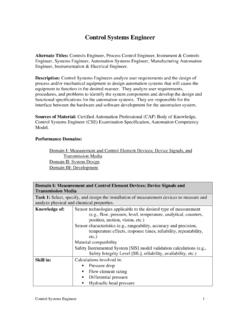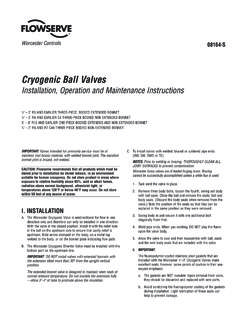Transcription of LMS Imagine.Lab AMESim Internal Combustion …
1 LMS AMESim Internal Combustion EngineLMS Internal Combustion engine LMS Internal Combustion engine helps users model and design comprehensive engine systems from air management and Combustion up to engine control by providing accurate physical engine models and components. LMS Internal Combustion engine has been developed in close collaboration with IFP. As a result, it offers a cutting-edge, flexible environment for designing and optimizing virtual engine and automotive subsystem concepts. Users have the ability to study couplings with fuel injection subsystems, vehicle thermal management, powertrain and any other components, and can adapt model definitions to a wide range of usage scenarios. Impact analyses of advanced technology choices can now be processed and analyzed on the Control Air Path Management Combustion Hybrid Vehicle Emissions ReferencesSiemens VDO - Gasoline engine ECU validation on HiLIFP - Observer design for downsized gasoline engine controlDelphi Diesel Systems - Diesel engine ECU validation on HiLToyota - Test of new warm-up strategies for fuel consumption reductionRenault - Development of VVA control strategies Fiat Powertrain Technologies - New Combustion concepts to satisfy future emission legislationLMS International | | Internal Combustion EngineFeaturesBenefitsEngine models running offline/ online (real time)A chain of models with associated methodology, suitable for every stage of the design process Non-linear engine models based on physics (including phenomenological Combustion models)
2 Several model levels available for most components (to find the best compromise between detailed description and CPU time) engine model can be linked to other AMESim model libraries (cooling system, transmission) to obtain a comprehensive model Compatibility with major hardware manufacturers for real-time simulation (Mathworks, NI, )Process more virtual adjustments and tuningImprove test quality and perform in- depth control validation thanks to more accurate and faster modelsDevelop more sophisticated and easy to calibrate control strategiesTake advantage of a single environment for engine and control design/validationGain in efficiency with easy-to-share modelsQuickly adapt to new projects with easy-to-modify models Reduce need for testing on account of real-time Combustion models based on geometrical parameters , improved test specification and better insightComprehensive engine actuators modeling A methodology has been set up to simplify high fidelity models into a mean value engine model.
3 Using the DOE tool embedded within LMS complete vehicle model including a mean value engine model as the core of an engine HiL test co-simulation between LMS AMESim and Simulink is used to design engine control strategies with the help of an engine -to-pilot model. LMS engine Control is a complete and integrated solution to design and set up robust engine controls. LMS engine ControlLMS engine Control is a complete and integrated solution to design and set up robust engine controls. From design to validation, it provides a relevant toolset to manage the growing complexity of engine control strategies and drive assistance technologies directly linked to the engine (speed regulation, gearbox). LMS engine Control goes further than the classical automatic control approach, and provides a unique methodology for control design. The solution is mainly based on a strong modeling competence and a thorough understanding of the system physics.
4 OEMs and suppliers, engine manufacturers, engine control designers and testers (HIL test-benches) will be able to use state-of-the-art engine models, suitable for every stage from design to validation, as well as in real time. By using LMS AMESim throughout the development process, project engineers can implement and capitalize on their own modeling know-how, and share models to gain time and efficiency. Model accuracy and real time analysis are no longer engine Control comes with a set of cutting-edge components:The LMS AMESim core platform Control-specific interfaces (Simulink and Real-Time) Links with market reference software : Simulink (Mathworks), Morphee2 (D2T), LabView RT (NI) Standard and specific libraries and components/models Analysis tools and methodologies for model reduction For more specific usage, detailed models of engine subsystems are available (injection, air loop, driveline, thermal, electrical actuators and motors) as well as analysis tools to study the Combustion process in real time.
5 Implementing LMS engine Control helps engineers reduce time to market (gain in efficiency) and design/validation costs (mainly reduce testing needs) while improving quality and robustness (better physical understanding, increase validation capacity). It offers unrivalled model-based, multi-domain system simulation within a single simulation platform, both in the design and validation process (Hardware-in-the-Loop and Software-in-the-Loop).LMS engine Control has been developed in close collaboration with IFP, ensuring delivery of cutting-edge, innovative and robust Internal Combustion EngineLMS International | | Combustion models for compression ignition and spark ignition applications coming from 3 DModular & multi-domain approach to model all kinds of configurations (system approach)Detailed modeling of air path actuators and sensors (valves, VVT, VVA)Phenomenological Combustion model to analyze impact on torque and emissionsSteady-state and transient operations Several levels of detail depending on the simulation constraintsInterface with Simulink for actuator/ system control designEfficiently test new technologies and designsAccess a balanced compromise between required simulation accuracy and calculation timesImprove data and model exchanges (collaborative work)
6 Optimize the design at the system level taking into account interactions with thermal aspects, Combustion and exhaustPredict the impact of the air path strategy on performance, noise, emissions and residual gasDirectly evaluate associated control strategiesDetailed modeling of a Variable Valve Actuation system coupled with a single cylinder diesel modular approach of AMESim makes it possible to design all kinds of air paths like dual-stage turbo can obtain a graphical representation of the interpolations results with Air Path Management provides a quickanalysis of the impact of technical architecture such asVVA Air Path ManagementLMS Air Path Management helps users to design all kinds of air path architectures - including exhaust systems - for any kind of technical choice. The solution provides a quick analysis of the impact of selected technical architectures (variable valve timing, turbo charging, exhaust gas recirculation, diesel particle filter).
7 It accurately manages the air mass and burned gas ratio in the Combustion technology focuses on how to maintain performance while reducing both emissions and fuel consumption. The main concern for cutting-edge engine design relates to NOx and CO2 emissions. Some of the major challenges that engineers are faced with today are accurately analyzing Combustion by mastering injection and in-cylinder gas composition as well as managing optimized downsizing associated with turbo charging. LMS Air Path Management is based on the AMESim multi-domain system simulation approach and on a set of libraries and component models, which provide the necessary tools to design advanced air path management strategies: mechanical, IFP- engine and thermal libraries, powerful analysis tools, turbo map pre-processing, linear analysis, Simulink interface, generic co-simulation to allow coupling with CFD Air Path Management helps to design all kinds of configurations and provides detailed modeling of air path actuators like valves, VVT, and VVA.
8 Moreover, with the phenomenological Combustion model the impact on torque, emissions and consumption can be analyzed. Furthermore, the interaction between air path and other engine subsystems can be detailed and LMS Air Path Management, engineers can efficiently test new technologies and designs, and take advantage of a balanced compromise between required simulation accuracy and calculation times. Finally, LMS Air Path Management directly evaluates the system s behavior and helps to define associated control strategies when coupled to the LMS engine Control solution. Engineers can focus on real issues rather than on the development and maintenance of engine models. The solution s flexibility and modularity makes it possible to implement and integrate the latest technological innovations. LMS Air Path Management has been developed in close collaboration with IFP, ensuring the delivery of cutting-edge, innovative International | | Internal Combustion EngineBenefitsFeaturesStraightforward 3D calculation integration in a system approachState-of-the-art 3D and 1D models suitable for various applications from large diesel to high-rev gasoline enginesState-of-the-art empirical models (Wiebe law)
9 With automated fitting toolAccurately predict boundary conditions for 3D calculations using 1D models Combine good prediction of Combustion heat release in 1D by integrating models and methodologies developed for 3D approachesIFP- engine proposes advanced Combustion models derived from 3D Combustion models, like Coherent Flame Model for spark ignition is embedded in the LMS AMESim environment as the 3D tool dedicated to CFD engine Combustion models in LMS AMESim taking into account geometry allow 3D visualization within Combustion supports the design and the optimization of new Combustion processes and adaptation of engines to alternative CombustionLMS Combustion supports the design and the optimization of new Combustion processes and adaptation of engines to alternative fuels. It helps users to optimize the cylinder geometry (piston shape, head, location of injectors, plug), to optimize engine parameters (such as advance, turbulence: swirl/tumble/squish, lambda control or injection ) for different fuel types, and study advanced Combustion processes including HCCI and CAI.
10 Combustion processes get increasingly complex in order to comply with conflicting demands. More stringent emission standards have to be met while customers desire higher engine response and lower noise levels. engine designers are therefore looking for interesting alternatives beyond the continuously evolving conventional gasoline Spark Ignition (SI) and diesel Compression Ignition (CI) combustions. LMS Combustion provides an efficient way to investigate the transient engine behavior by using an unparalleled numerical multi-domain system simulation approach. The IFP- engine library provides dedicated components for Combustion simulations and can be seamlessly coupled with 3D Combustion codes and models (like IFP-C3D).LMS Combustion provides the ideal toolset to analyze the dynamic behavior of any Combustion process, and enables flawless 3D calculation integration in a system approach. Dedicated libraries come with state-of-the-art 1D and 3D models suitable for various applications from large diesel to high-rev gasoline Internal Combustion EngineLMS International | | can analyze and validate the power management of hybrid powertrain systems.

